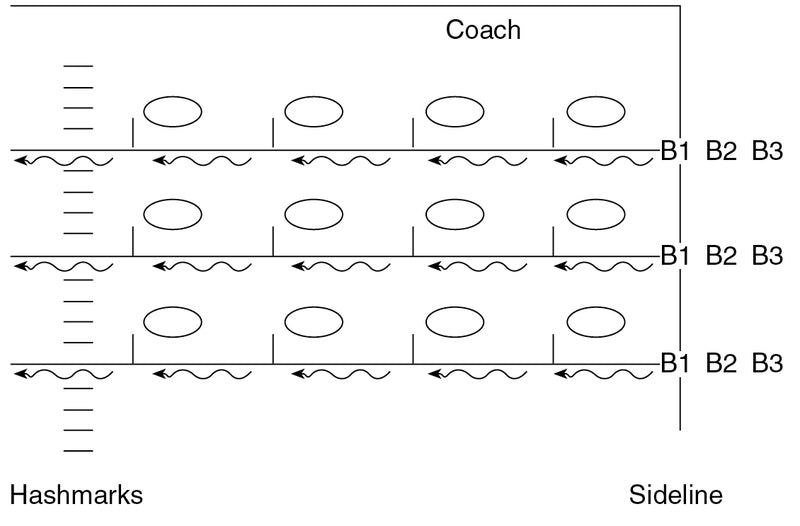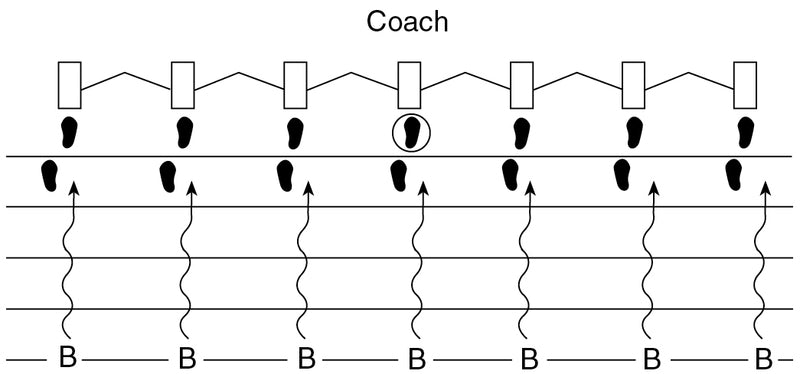Four Hit-and-Shed Drills for Developing a Championship Base
This is an excerpt from Complete Linebacking-2nd Edition by Lou Tepper.
Hit-and-Shed Drills
Here are a sampling of drills to get proper repetitions for each of the coaching points discussed in chapter 1. A correct base will yield tremendous results, but to achieve it you must drill it so often that it becomes the only comfortable reaction to blockers. Linebackers must become like cats and always land with a correct base.
Use your imagination to create other meaningful drills to improve the areas in which your team needs work.
Air Drill
This is the first drill we use after a linebacker understands the three possible bases. The purpose is to get a high number of repetitions with a correct base. It takes little effort and produces repetitions quickly. We often see our linebackers doing this drill on their own before practice.
Put all your linebackers on a line facing you. On the command “ready hit” each steps forward with his front foot. Check to see initially that their weight is over the lead foot. Remind them that the step is a short one, so they can get good hip roll. Also check that they point the toe at the target. Once they have the concepts, get a ton of reps with the right foot and then the left by having them return to their original stance immediately after the “ready hit” command (see figure 3.9).

Shuffle Set Drill
This is another high-repetition drill without contact that can be done with or without pads. It introduces movements while setting a base. Simply have the linebackers align on the sideline every 5 yards all facing the same direction. On command have them shuffle down their line (see figure 3.10). When they hear “left” or “right,” they should establish a base with the assigned foot. Then they push off that base and continue to shuffle, usually to the near hash, and set their base against the air at least four to six times.
The shuffle is discussed with pursuit in chapter 4. This drill ties that movement in a high-contact area to a perfect base. Stress that the linebacker’s base should be short and firm with weight over the lead (front) foot. Also focus on pushing off the lead foot as the key to separation from the blocker.

Sled, One-Step Drill
This drill provides limited contact one step away from a perfect base. After your players establish the correct compact base, you can emphasize hip roll.
Any sled will do, but we prefer a stationary seven-man sled. Draw five 1-yard lines in front of and parallel to the sled. Seven players align one step (usually 1 yard) from contact, each shading a pad with his lead foot aligned in the middle of the pad.
On a “ready hit” command each of the seven linebackers steps with his lead foot and lightly touches the pad with his contact surface. The emphasis is always on foot placement first. Get the desired base and all else will fall into place. Practice a right-footed base and the next time up a left-footed one. Again, you can do many repetitions in a short time.
After a few times through without contact, have them explode with their hips off that base. Players should feel the power surge as the sled rocks upward off the ground (see figure 3.11).

Sled Approach Drill
Again, any sled will work, but a stationary seven-man sled allows more players to drill. Draw lines on the field so players know their depths.
Back up the linebackers at various depths so that on “ready hit” they can approach and set their bases on the designated pads. Now the athlete gets to work on his particular approach. Some will skip or hop to set their bases. That’s fine as long as they plant the front foot before they contact the pad. It should be bang, bang. First the foot hits the ground, and then the player makes contact with the pad. If the player makes contact with the pad first, the front foot is in the air on contact, resulting in the dreaded pancake base.
This is another drill individual athletes can do in prepractice. It gives them great confidence in their approach to setting a base (see figure 3.12).

SHOP

Get the latest insights with regular newsletters, plus periodic product information and special insider offers.
JOIN NOW


